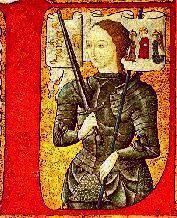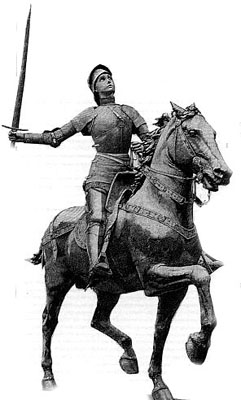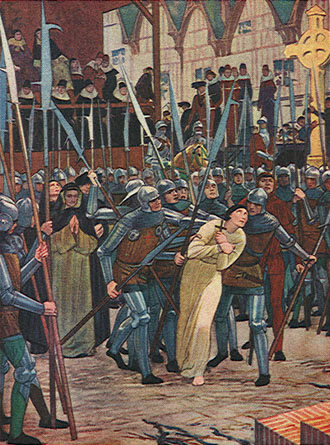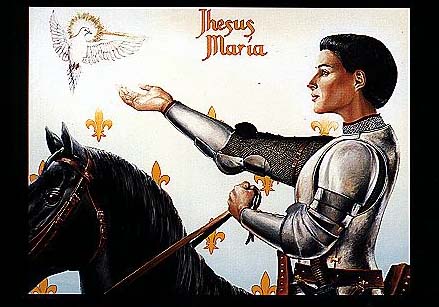| Model of Faith: Joan of Arc |
 |
| www.newgenevacenter.org/ portrait/joan-arc.jpg |
 |
 |
| www.terrace.qld.edu.au/.../ graphics/joanpic.jpg |
| http://www.terrace.qld.edu.au/academic/ lote/french/graphics/jarc2.jpg |
| Saint Joan was born on January 6, 1412, in the village of Domremy to Jacques and Isabelle d'Arc. Joan was the youngest of their five children. While growing up among the fields and pastures of her village, she was called Jeannette but when she entered into her mission, her name was changed to Jeanne, la Pucelle, or Joan, the Maid. As a child she was taught domestic skills as well as her religion by her mother. Joan would later say, "As for spinning and sewing, I fear no woman in Rouen." And again, "It was my mother alone who taught me the 'Our Father' and 'Hail Mary' and the 'Creed;' and from none other was I taught my faith." From her earliest of years Joan was known for her obedience to her parents, religious fervor, goodness, unselfish generosity and kindness toward her neighbors. Simonin Munier, one of Joan's childhood friends, tells how Joan had nursed him back to health when he was sick. Some of her playmates teased her for being 'too pious.' Others remembered how she would give up her bed to the homeless stranger who came to her father's door asking for shelter. Joan was 'like all the others' in her village until her thirteenth year. "When I was about thirteen, I received revelation from Our Lord by a voice which told me to be good and attend church often and that God would help me." She stated that her 'Voices' were Saint Michael the Archangel, Saint Catherine and Saint Margaret. At first her 'Voices' came to her two or three times a week but as the time for her mission drew near (five years later), they visited her daily telling her to 'Go into France' to raise the siege of Orleans, conduct the Dauphin Charles to Reims for his crowning and to drive the English from the land. |
| Joan went to the neighboring town of Vaucouleurs, which means Valley of many colors. There she spoke to the loyal French governor by the name of Sir Robert de Baudricourt. After many rejections he finally agreed to send her to the Dauphin who at the time was living at the castle of Chinon. On the evening of February 23, 1429, she began her mission for God. In the company of six men, she rode through the Gate of France on her way to Chinon. Joan reached this town on March 6th, but was not received by the Dauphin, Charles, until the evening of March 9th. After being accepted and approved by a Church council headed by the Archbishop of Reims, Joan was allowed to lead the Dauphin's army. This part of her career was meteoric. She entered Orleans on the evening of April 29th and by May 8th the city had been freed. The Loire campaign started on June 9th and by June 19th the English were driven out of the Loire valley. The march to Reims started on June 29th and by July 17th Charles was crowned King of France in the cathedral of Reims. From this time on, for reasons know only to King Charles, the king no longer valued Joan's advice and guidance. She had always told him that God had given her 'a year and a little longer' to accomplish His will but the king seemed to take no notice of it. For almost a year he wasted what time remained to Joan, until in frustration, she left the court. Her last campaign lasted from the middle of March until her capture at the town of Compiegne on May 23rd, 1430. Her 'year and a little longer' was over. Abandoned by her king and friends, she started her year of captivity. As a prisoner of the Burgundians she was treated fairly but that all changed when on November 21st, 1430, she was handed over the English. How she survived their harsh treatment of her is a miracle in itself. The English not only wanted to kill Joan but they also wanted to discredit King Charles as a false king by having Joan condemned by the Church as a witch and a heretic. To obtain this goal the English used those Church authorities whom they knew to be favorable to them and the staunchest of these was Bishop Cauchon. Joan's trial of condemnation lasted from February 21st until May 23rd. She was finally burnt at the stake in Rouen's market square on May 30th, 1431. Twenty-five years later the findings of Joan's first trial were overturned and declared 'null and void' by another Church court, who this time was favorable to King Charles. It was not until 1920 that the Church of Rome officially declared Joan to be a saint. Her feast day is celebrated on May 30th. |
| http://www.stjoan-center.com/#bio |
 |
| www.stjoan-center.com |
| Joan of Arc is a wonderful example of faith for anyone who doesn�t have a perfect understanding of what they believe. In other words she is a model for everyone. She had no real education in her faith and had very little complex knowledge of the Catholic religion. Even with so little understanding she had a strong faith and did a magnificent job of living by it. Joan heard the voices of saints and never doubted what they told her. She was put through a great deal of persecution, including being shot twice and eventually death, because she believed so strongly in what she was told. Joan didn�t have any special training for what she was sent to do, but she had faith that God would guide her in the right direction and protect her. She was even willing to give her life for what she believed and died a very horrible death because of it. Joan demonstrated many aspects in her faith. One that seemed so significant was the certainty of her faith. I had never really understood how faith could be certain, but I think that Joan�s faith was exactly that. She didn�t doubt that saints were actually speaking to her, and she was so certain that she never gave up pursuing what they told her. This also seems to incorporate the idea of faith as a free human response. She had to respond to the voices when she could have just ignored them. She also had to have the extremely courageous will to get her message across in a society that had little respect for women, especially of Joan�s status. Her task was certainly hard and she faced it with a certainty in her faith that we should all model. |
| Another thing that I had never been able to understand was how faith could be both certain and have risk. Joan of Arc seemed to have just that in her faith. She was certain that God was calling her to do the right thing but she also understood, especially when she was told she would be wounded and also die, that a great deal of risk was involved. The risk that she faced was a physical risk, while the certainty that she had was based on her spirituality. I now understand that the aspect of risk can come in one place while certainty can come in another. Joan shows us how we can have both in our faith. |
| The idea of a peak experience was something that I felt could happen, and I even felt that I had maybe experienced it in some way before. Though I did not feel that it was something that one person could experience many times. Joan�s incidents changed my opinion. Hearing voices were peak experiences for her. She could not have had those experiences and not felt a significant increase in her spirituality. Even thought they certainly occurred often for her, she must have had a sense of awe upon hearing the voices of saints. If she hadn�t she would have thought that she was going crazy. Each experience opened her to God�s power, and each time she felt that she was called to act upon her faith to do God�s will. Joan�s voices were peak experiences in her life and guided her on her journey. One thing about Joan�s life that seemed so hard for me to understand was why God instructed her to lead a nation of people into a war. I understand that the war was already being fought, but if there is always a nonviolent way to end disputes then why did God decide to inspire a peasant girl in France to lead an army to kill thousands of other humans? Why did God give France the ability to defeat their enemy in battle rather than solving the war in a more peaceful way? I would like to believe that there is always a peaceful way to solve our problems, but the story of Joan of Arc leads me to believe that sometimes violence is necessary. Even with the questions that Joan of Arc�s story brings up, I feel that she is a wonderful model of faith. She demonstrates many aspects of strong faith and gives us an example of how to live it out. I know that most of us do not have voices in our heads telling us what to do, but we all have a sense of how God is calling us to act. We must try to live out our faith with courage and do whatever it takes to do God�s will. |

|